A tour through Oman has been on our wish list for a few years now. We have a weakness for Arabic cultures and oriental food. But what makes the Sultanate so special are undoubtedly its diverse landscapes, from the glowing red sand dunes of the Wahiba Desert to the impressive mountain ranges of the Hajar Mountains. Added to that are countless dream beaches, lush wadis, historic fortresses, picturesque oasis towns, and plenty of hospitality.
Our Oman road trip took us crisscrossing the country for 17 days. And what can we tell you? This trip was by far one of the most intense, beautiful, and exciting tours we’ve ever taken.
Oman captivated and fascinated us from the very beginning. We highly recommend a trip through the land of frankincense! In the following article we will reveal our travel route through Oman, the individual highlights and numerous travel tips.
- Oman tour – Our 17-day route
- Who is this Oman tour suitable for?
- Day 1: Arrival in Oman & accommodation
- Day 2: Explore Muscat
- Day 3: Excursion to the Daymaniat Islands
- Day 4: Nizwa & Birkat al Mouz
- Day 5: Jebel Shams and Balcony Walk
- Day 6: Bahla & Misfaht Al Abriyyin
- Day 7: 1000 km to Salalah
- Day 8: Explore Salalah & beaches
- Day 9: Mughsail Beach & Fazayah Beach
- Day 10: Wadi Darbart & Taqah
- Day 11: Oman Ocean Drive to Duqm
- Day 12: Visit Lizq Oasis Farm
- Day 13: Our night in the Wahiba Sands Desert
- Day 14: Wadi Bani Khalid & Sur
- Day 15: Wadi Shab & Accommodation by the Sea
- Day 16: Wadi Al Arbeieen
- Day 17: Return to Muscat & Journey Home
- Arrival by plane
- Entry & Visa
- When is the best time to travel to Oman?
- Is Oman a safe travel destination?
- Which accommodations do you recommend?
- Where is the best place to book a rental car for Oman?
- Oman Road Trip – How safe is driving?
- How much does such a tour cost?
- Packing List – What shouldn’t I forget?
- Which travel guide do you recommend?
Oman Tour – Our 17-Day Route
Before the Oman tour, we spent a long time thinking about which parts of the country we actually wanted to explore. If you take a look at the standard travel guides, you’ll quickly find some good pointers for route planning. It became clear to us relatively quickly: If we were to travel to Oman, we wanted to explore both the north and the south.
And so we spent the first 7 days in the north, then 5 days in the south, and finally another 5 days in the north. If you only have 7 to 10 days, we recommend the north. There you can explore many fantastic landscapes and places in a very short time. Whether mountains, beaches, islands, desert, or oases – in the north you get the complete package.
As the icing on the cake, you can also include the south in your trip if you have enough time. While we drove the almost 1,000 kilometers from north to south in one day, others take the plane quite comfortably. Flights with SalamAir start at just €70 and with Oman Air at €100.
Oman Road Trip & Itinerary (17 days)
Our overnight locations in Oman:
- 3 nights in Muscat
- 1 night in Birkat al Mouz
- 1 night in Jebel Shams
- 1 night in Misfah al Abriyyin
- 3 nights in Salalah
- 1 night in Taqah
- 1 night in Duqm
- 1 night in Lizq
- 1 night in Wahiba Sands
- 1 night in Sur
- 1 night in Wadi Shab
- 1 night in Wadi Al Arbeieen
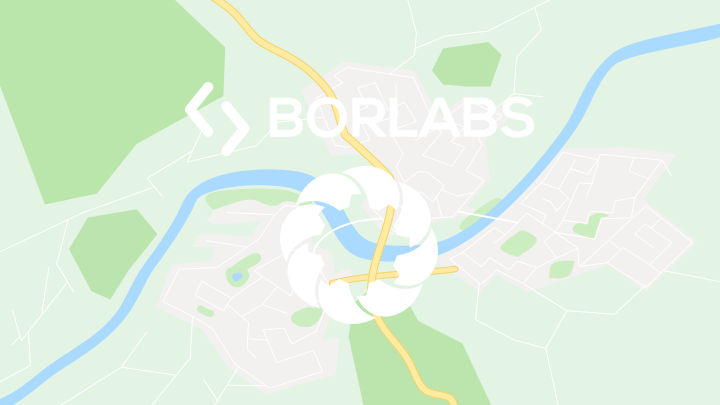
By loading the map, you accept Google’s privacy policy.
Learn more
Load map
Who is this Oman tour suitable for?
Our trip is primarily suitable for independent travelers who enjoy exploring a country on their own. While we didn’t rush from A to B, we often only stayed in one place for one night on these explorations. This was partly due to the fact that we wanted to travel across the country within 17 days and therefore didn’t have any long stays planned.
You have to like that, of course. If you have more time, you can take significantly more time and stay longer. For us, the mix was perfect, and at no point did we feel stressed or hectic. We also didn’t plan too much each day, so we always had enough time to relax and enjoy ourselves.
What awaits you in the Land of Frankincense:
- Diverse landscapes (mountains, deserts, coast, beaches, islands, oases…)
- Adventure opportunities (hiking, diving, canyoning…)
- Traditional Arabic culture & hospitality
- Arabic cuisine with a strong Indian influence
- Rich history and a deep cultural tradition
- The country is also one of the safest countries in the world
Day 1: Arrival in Oman & Accommodation
- Daily distance: 4,930.32 km as the crow flies from Munich to Muscat
- Accommodation: Aloft Hotel Muscat*
- Highlights: Airport lounge in Abu Dhabi, Aloft Hotel with terrace and pool
- Activities: Half-day city tour with audio guide*
Late in the evening, we landed at Muscat International Airport. Unfortunately, everything took a little longer here, as we had to fill out a form for our lost suitcase right at the start of the trip. The suitcase hadn’t made the transfer in Abu Dhabi, so they wanted to send it on a later flight. Two days later, we were actually able to pick up the suitcase at our hotel. We were lucky!
On the evening of landing, we took a taxi to our hotel for 4 rials (approx. €10). The Aloft Hotel in Muscat* is only 10 minutes from the airport and therefore easy to reach. We arrived at the hotel very late (around 11:45 p.m.) and were very happy that we were able to get something hot to eat in the lounge in Abu Dhabi. So all we had to do was take a shower and go to bed.

Day 2: Exploring Muscat
- Daily distance: 50 kilometers
- Accommodation: Aloft Hotel Muscat*
- Highlights: Mutrah Fort, Mutrah Souks, Mutrah Corniche
- Activities: Half-day city tour with audio guide*
The next morning, we started the day quite leisurely. For Muscat, we can recommend the two taxi apps “OTAXI” and “Marhaba.” These apps work similarly to UBER, making it easy to order a local taxi (internet connection required). Important to know: Muscat is not a city you can explore on foot. The sights are mostly far apart, which is why you get from point A to point B by taxi.

A driver took us to the Mutrah district, where we not only visited the Mutrah Fort and the Mutrah Souk (bazaar/market), but also the Sultan’s Palace (Al Alam Palace) and the promenade (Mutrah Corniche). Take a look at the water here; you might even see a few sea turtles like we did. In Mutrah, you can also marvel at the Sultan’s enormous yacht, which spends most of its time in the harbor.
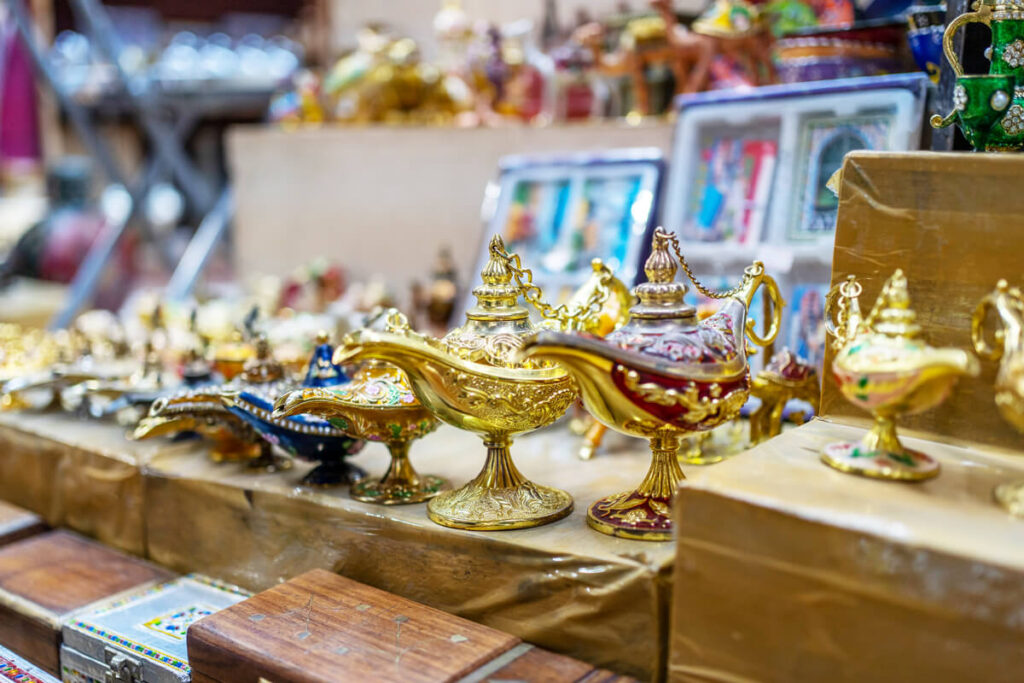
In Mutrah, we can recommend the Bella Vista Café, which is currently run by two super cool Indonesians. The coffee made by the two baristas is excellent, as is the cheesecake. After our first exploration, we returned to the hotel and ended the evening in the hotel restaurant. Afterwards, we played a round of billiards in the lobby before falling into bed, happy and content.
Day 3: Excursion to the Daymaniat Islands
- Daily distance: 85 kilometers
- Accommodation: Aloft Hotel Muscat*
- Highlights: Daymaniat Islands, Royal Opera House, Qurum Beach
- Activities: Snorkeling trip to the Daymaniat Islands*
The third day of our Oman tour had several highlights in store for us. Early in the morning, we took a taxi for 4.5 rials to the harbor in Seeb (approx. 25 minutes), as our tour to the Daymaniat Islands started there. With about 10 other guests, we set off for the small archipelago, which lies just 18 kilometers off the Omani coast. There, we saw countless turtles, reef sharks, and many colorful fish. It was an unforgettable experience.
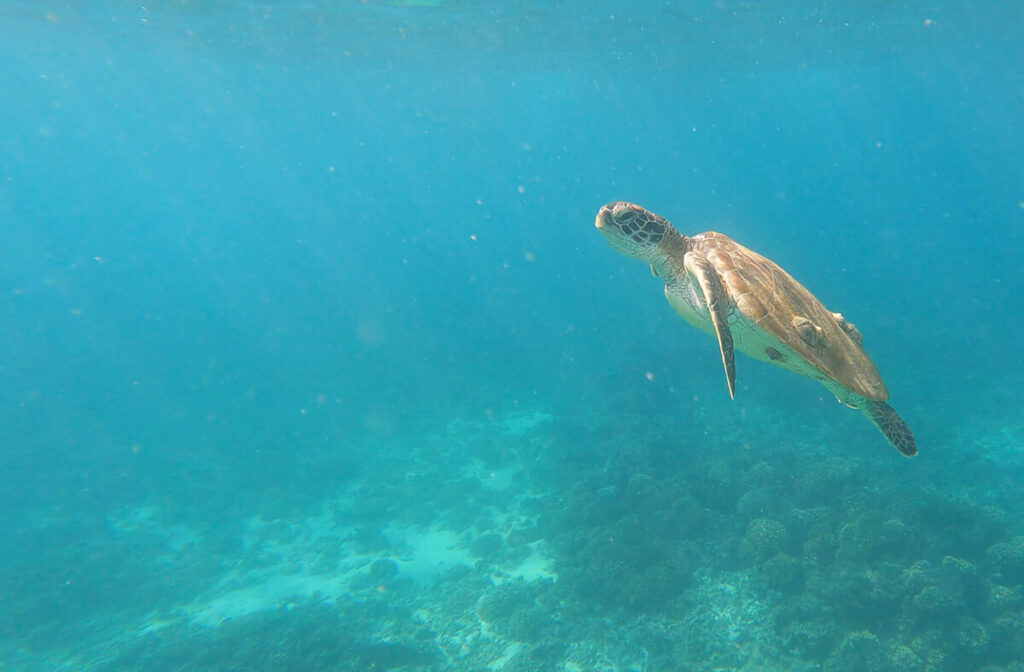
In the afternoon, we were driven to the impressive Royal Opera House in Muscat. The royal opera house opened in 2011 and is particularly impressive due to its impressive entrance area and a remarkable theater hall. The facade was clad in pink limestone from the Omani desert.
Afterwards, we strolled to the popular Qurum Beach, where we enjoyed the sunset among the locals. We ended the exciting day at the Slider Station restaurant with delicious salads, cool drinks and a view of the sea.
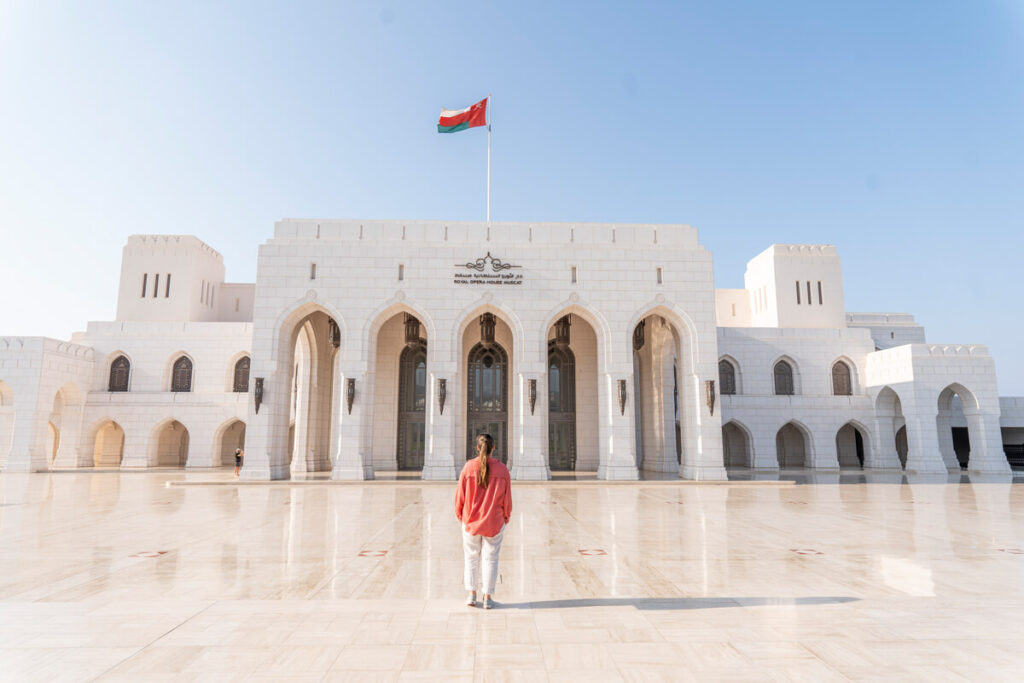
Day 4: Nizwa & Birkat al Mouz
- Daily distance: 177 kilometers
- Accommodation: Bait AlSabah Heritage Inn & Cafe*
- Highlights: Sultan Qaboos Grand Mosque, Nizwa Fort & Souks, Birkat al Mouz Ruins
- Activities: Full-Day Nizwa Tour with Audio Guide*
Early in the morning of the fourth day, we took a taxi and drove to the Sultan Qaboos Grand Mosque. As a non-Muslim, you can only visit it Monday to Thursday between 8 and 11 a.m. Women must cover themselves and wear long clothing and a headscarf. For men, a T-shirt and shorts (knee-length) are acceptable.
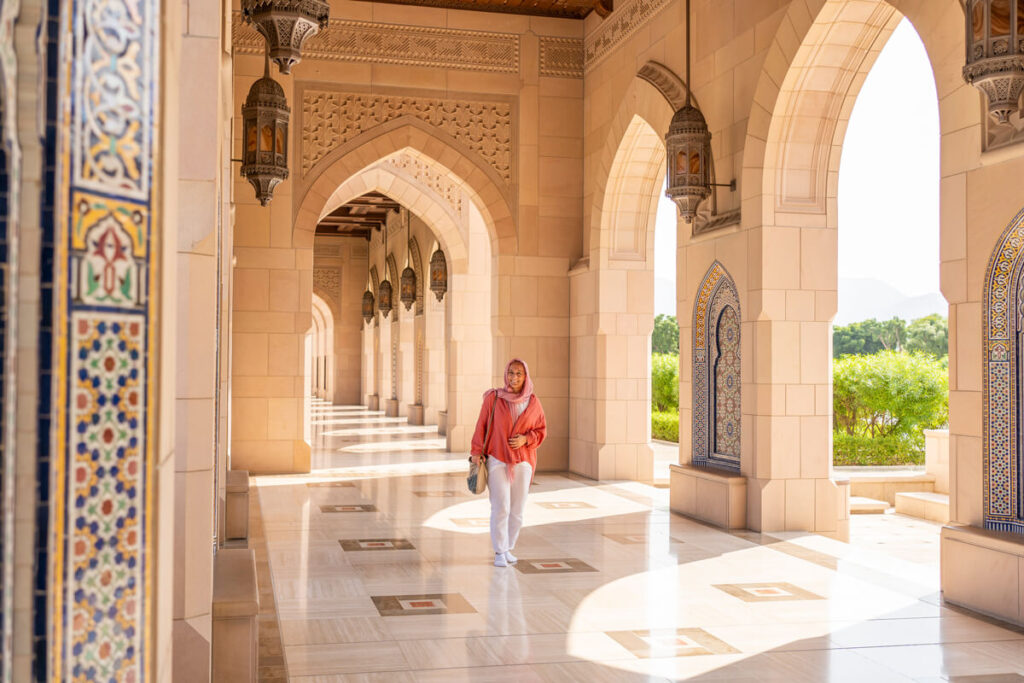
After visiting the mosque, we took a taxi to the airport, where we picked up our rental car (Toyota RAV4). We quickly drove back to the hotel to load our luggage. Afterward, our grand tour of Oman finally began. The first stop on this tour: the oasis town of Nizwa, one of the oldest towns in Oman and boasting a rich history and cultural significance.
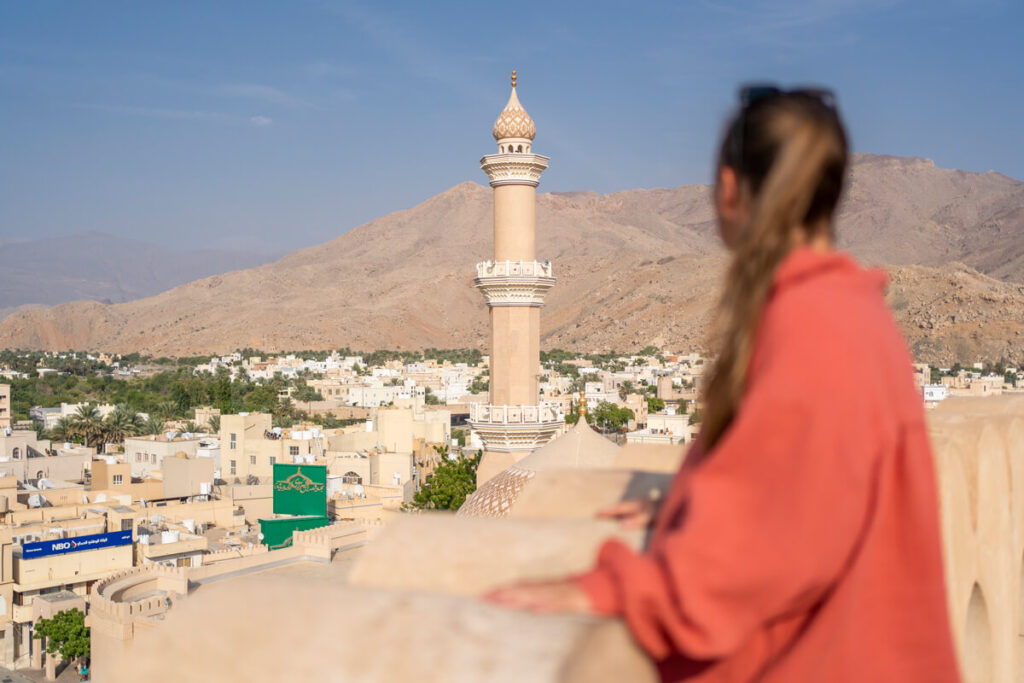
In Nizwa, we naturally explored the fortress (Fort Nizwa) and then the bustling souks. We also have a café tip for you: the Athar Café, with a terrace overlooking the fortress. Afterwards, we drove to Birkat al Mouz. The old mud-brick village is largely deserted and is located on a rock above the oasis. These ruins form an exciting contrast to the rest of the town. We checked into our room at the beautiful Bait AlSabah Heritage Inn & on the edge of the ruins. Cafe*.
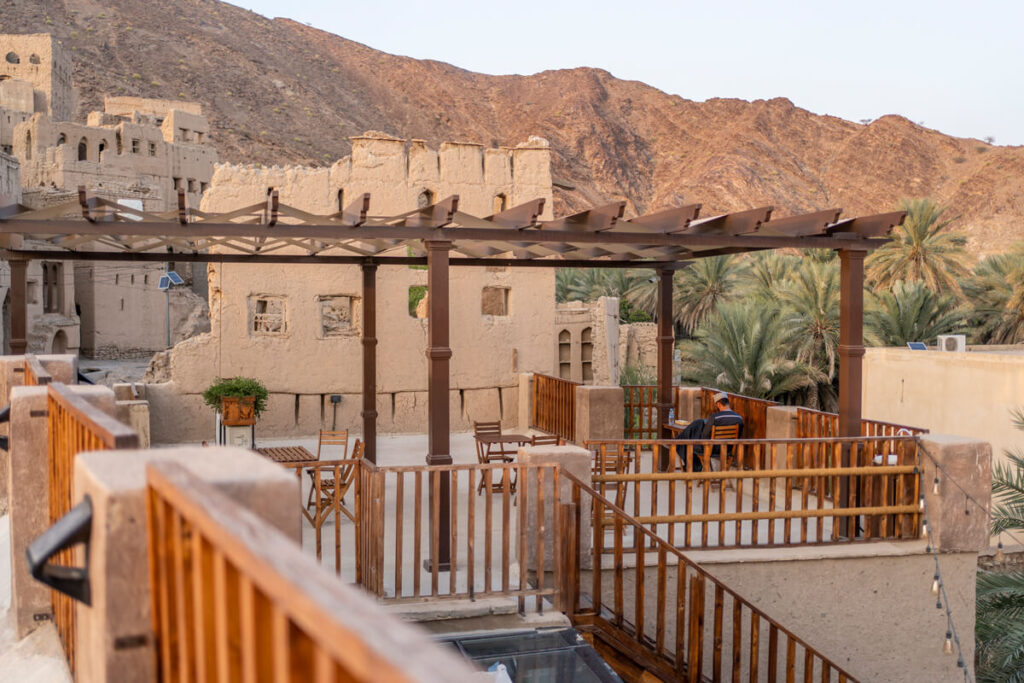
Day 5: Jebel Shams and Balcony Walk
- Daily distance: 99 kilometers
- Accommodation: Sama Heights Resort*
- Highlights: Jebel Shams Viewpoints, Balcony Walk, Sunrise, Cliff Café
- Activities: Nizwa and Jabal Shams – Full-day private tour*
New day, new adventure. The next morning, we continued from Birkat al Mouz toward Jebel Shams, the highest mountain in Oman at 3,009 meters. This imposing peak is an integral part of the Jebel Akhdar mountain range and is located about 240 kilometers from Muscat.
An absolute must for us on this trip were the Jebel Shams Viewpoints, which offer breathtaking views of Oman’s “Grand Canyon” (Wadi Nakhar). From these viewpoints, the view extends over the gigantic depths of the canyon, with the abyss reaching almost 1000 meters in some places.
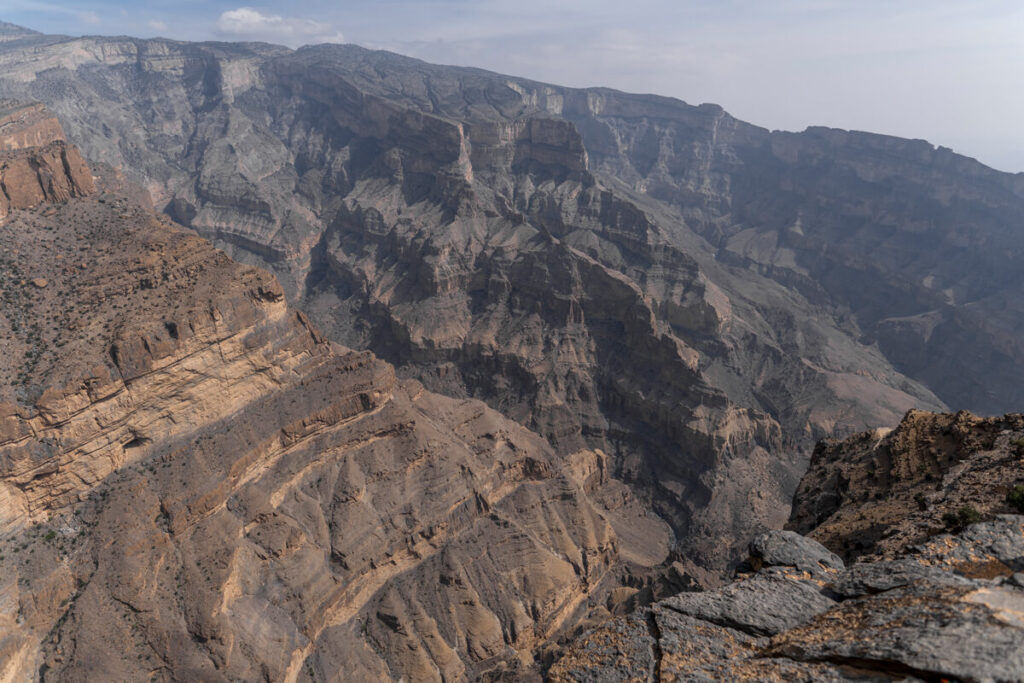
After enjoying the views, we decided on the so-called “Balcony Walk”, which is part of the W6 hiking trail and begins at the end of the road in the small village of Al Khitaym. Once you arrive at the parking lot, you can park your car for free and also take the opportunity to use the restroom or buy some snacks and drinks.
The hiking trail then continues along the canyon, with some narrow and steep paths and steep cliffs. Enjoy the many magnificent views along the way. Learn more here: Balcony Walk & Jebel Shams.
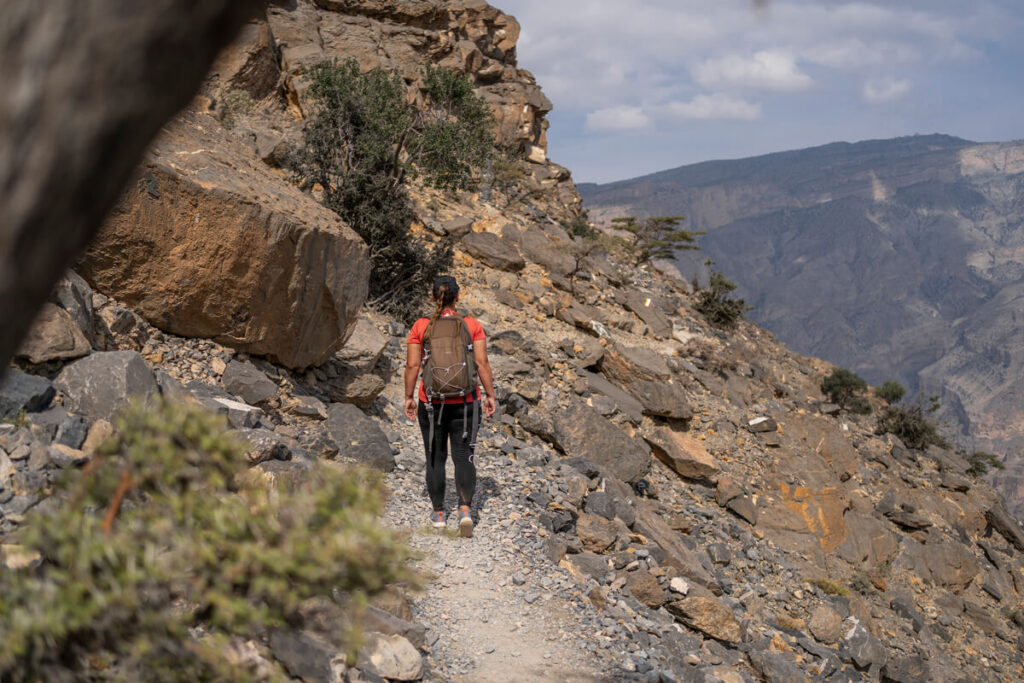
Day 6: Bahla & Misfaht Al Abriyyin
- Daily distance: 85 kilometers
- Accommodation: Harit AL Misfah Inn*
- Highlights: Bahla Fort, mountain village of Misfaht Al Abriyyin
- Activities: Nizwa Heritage: Abandoned villages, date farms, Falaj Daris*
After a spectacular sunrise in the mountains at the Cliff Café, we enjoyed breakfast at Sama Heights Resort. Afterwards, we packed our things and set off for Bahla. In this small oasis town, we explored the imposing Bahla Fort, one of the oldest and largest mud fortresses in Oman. After a detour to the charming souk opposite and the Bun Almdr Roastery café, we continued our tour.
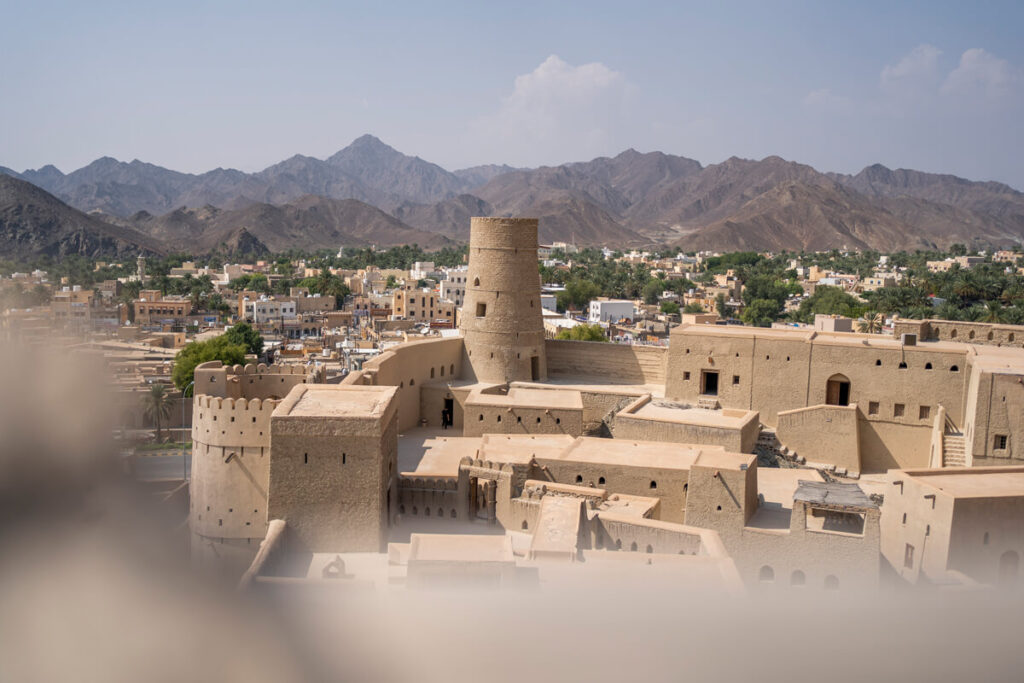
We spent the second half of the day in the charming mountain village of Misfaht Al Abriyyin, which lies at an altitude of almost 1,000 meters. A special feature of the village are the fields, which the residents have been cultivating for centuries in terraces for agriculture.
Date palms and bananas, in particular, thrive here. Using the traditional irrigation system, also known as “Falaj,” people channel water from the surrounding mountains through underground and open canals to their lush terraces and gardens.
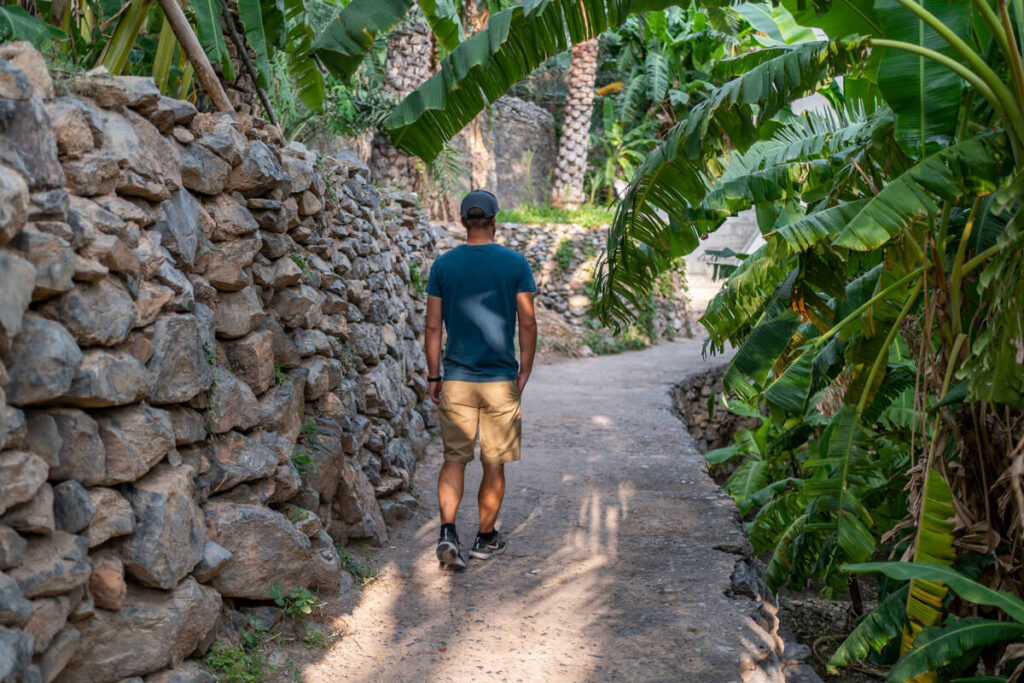
Day 7: 1000 km to Salalah
- Daily distance: 945 kilometers
- Accommodation: Apartment Mimosa*
- Highlights: the drive through “nothingness,” camels on the roadside, Leo Café in Haima
The day started at 7 a.m. because we wanted to leave as early as possible. Ahead of us lay what was probably the longest stretch we’d ever driven in one go. To be honest, we were a little apprehensive about the trip, as we didn’t know what to expect.
After a quick breakfast, we set off. The highway was two-lane for the first 390 kilometers, which made driving very pleasant. In general, the entire route to Salalah is very well developed and in top condition.
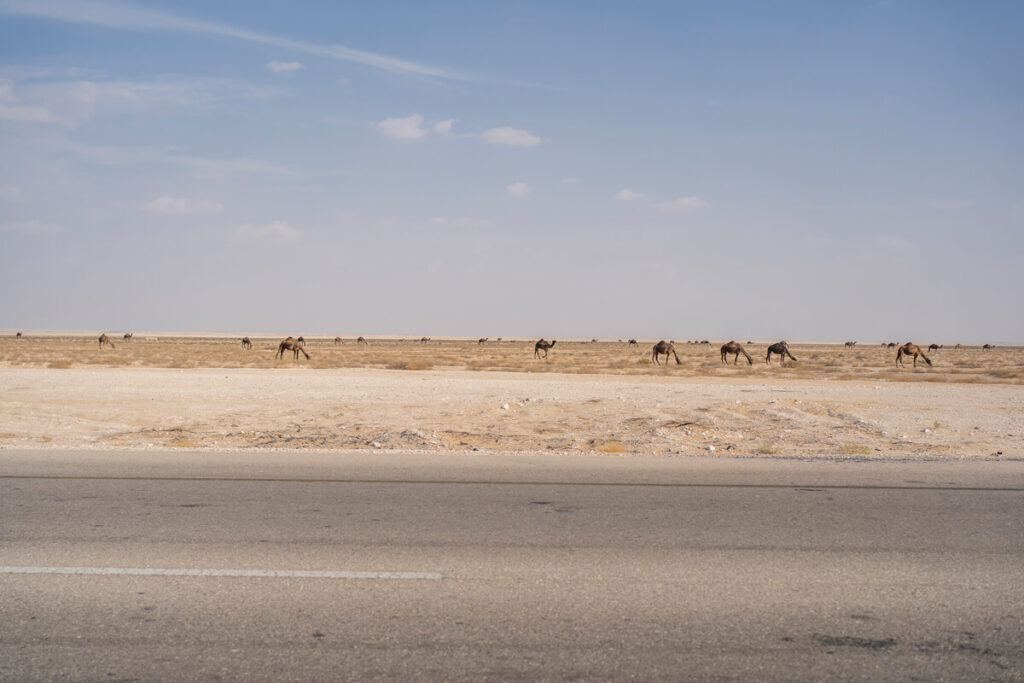
We drove for almost 4.5 hours to Haima, where we took our first break. There we could enjoy a good coffee, something to eat, and refuel the car. We then continued at 120 km/h for almost 5.5 hours to our destination. There was nothing to see along the way, except the vast, barren, and, above all, dusty landscape.
So we could just drive through with a clear conscience and didn’t miss anything along the way. Every now and then we spotted camels on the side of the road, but fortunately they were always far away from the road.
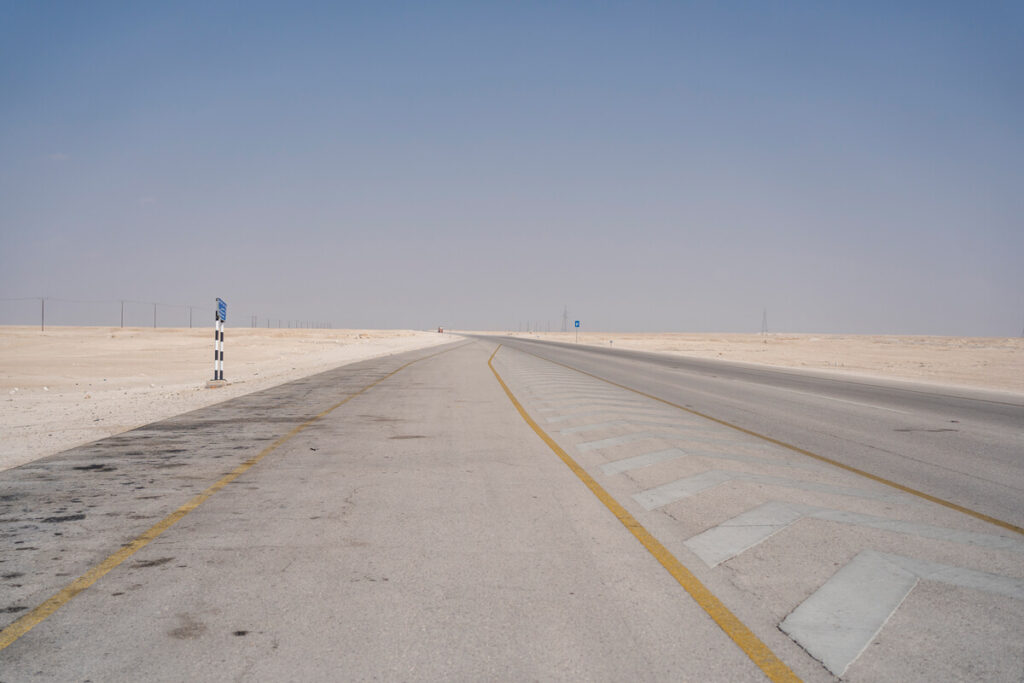
On the way, we passed four or five police and army checkpoints. Here we always had to show our passports and driver’s license. After a quick look at our papers, they let us continue on our way. So, everything was completely problem-free.
Around 6:30 p.m. we reached our accommodation in Hawana Salalah. We only had to drive in the dark for the last half hour, but this wasn’t a problem at all thanks to the abundant street lighting around Salalah.
Day 8: Salalah & Exploring the beaches
- Daily distance: 45 kilometers
- Accommodation: Apartment Mimosa*
- Highlights: Mosque in Salalah, Coconut Beach, Al Haffa Beach, Hawana Salalah
- Activities: 4-hour private sightseeing tour of Salalah*
Well-rested and refreshed from the long drive, we started the day comfortably in our apartment with a view of the palm trees. We later drove to the city of Salalah and first visited the Sultan Qaboos Mosque. It is the second largest in Oman and can be visited daily (except Fridays) from 8 a.m. to 11 a.m.
For good coffee and cake, we can recommend the Moin Café and the Bon Lab Café. In the best weather, we explored the very beautiful beaches of Coconut Beach and Al Haffa Beach, which impressed us with their huge palm trees and white sand.

Day 9: Mughsail Beach & Fazayah Beach
- Daily stage: 188 kilometers
- Accommodation: Apartment Mimosa*
- Highlights: Mughsail Beach, Blow Holes, Fazayah Beach, camels on the beach
- Activities: Salalah East Adventure: Waterfalls, Mountains & Safari*
On the ninth day of our grand Oman tour, we had two very special spots on our list. Our first stop was Al Mughsail Beach, where we encountered numerous camels along the roadside. Sometimes you can even see them directly on the beach or in the water.
At the end of the beach is the Marneef Cave and the so-called “Blow Holes,” from which seawater is catapulted many meters into the air. You can learn more about it in our article about the top sights in Oman.

After a short cola break at the Al Marnife Restaurant, we continued on to the second spot, Fazayah Beach. The path to the beach is a bit arduous towards the end, as it descends steeply on an unpaved road. However, with a four-wheel drive vehicle, this journey is no problem at all.
Once you’ve reached the bottom, you can drive into one of the bays and jump into the sea. The beaches there are stunningly beautiful. We saw turtles and dolphins. Incredible! There’s no infrastructure at all on site. Bring enough snacks, drinks, sunscreen, and swimwear. A parasol is a plus!
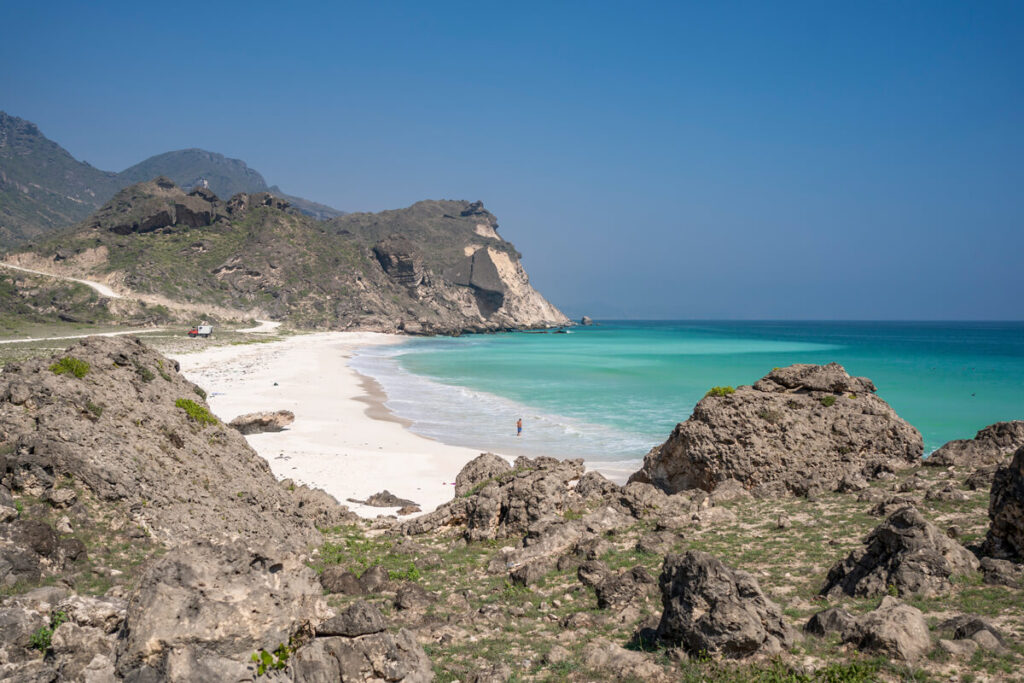
Day 10: Wadi Darbart & Taqah
- Daily distance: 38 kilometers
- Accommodation: Koofan Heritage House*
- Highlights: Wadi Darbat, Koofan Heritage House, Taqah (beach, viewpoint, castle)
- Activities: Salalah East Adventure: Waterfalls, Mountains & Safari*
On the tenth day of our tour, we left our cool apartment in Hawana Salalah and made our way to Wadi Darbat, about 30 kilometers away. During the Khareef season, which lasts from June to September, Wadi Darbat undergoes an astonishing transformation.
The valley turns green, and seasonal streams create beautiful waterfalls and flowing waters. A little further upstream, you’ll find picnic areas and a small snack bar. During the Khareef season, you can also rent small boats and cruise across the river.
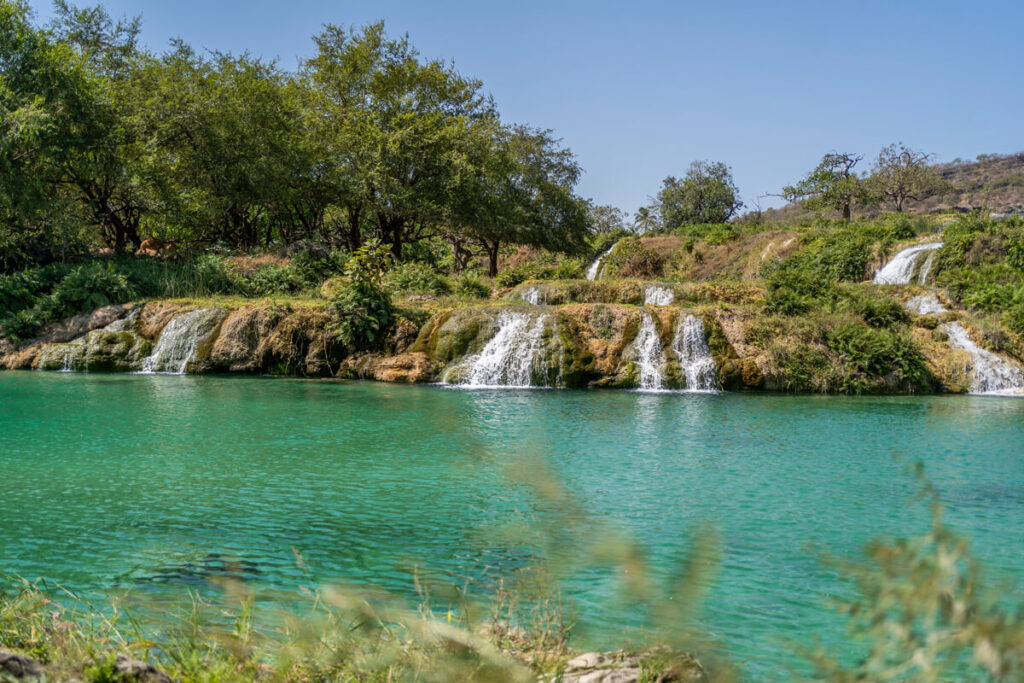
We spent the afternoon in the small coastal town of Taqah. There, you’ll find not only a beautiful beach, a small “castle,” and an imposing rock that offers an excellent view of the sunset, but also a very special accommodation.
The Koofan Heritage House* is a museum, café, souvenir shop, and hotel all in one. The approximately 150-year-old traditional mud and stone house has been painstakingly restored by the owner’s family. We had a wonderful stay at this accommodation and can only recommend it to you.
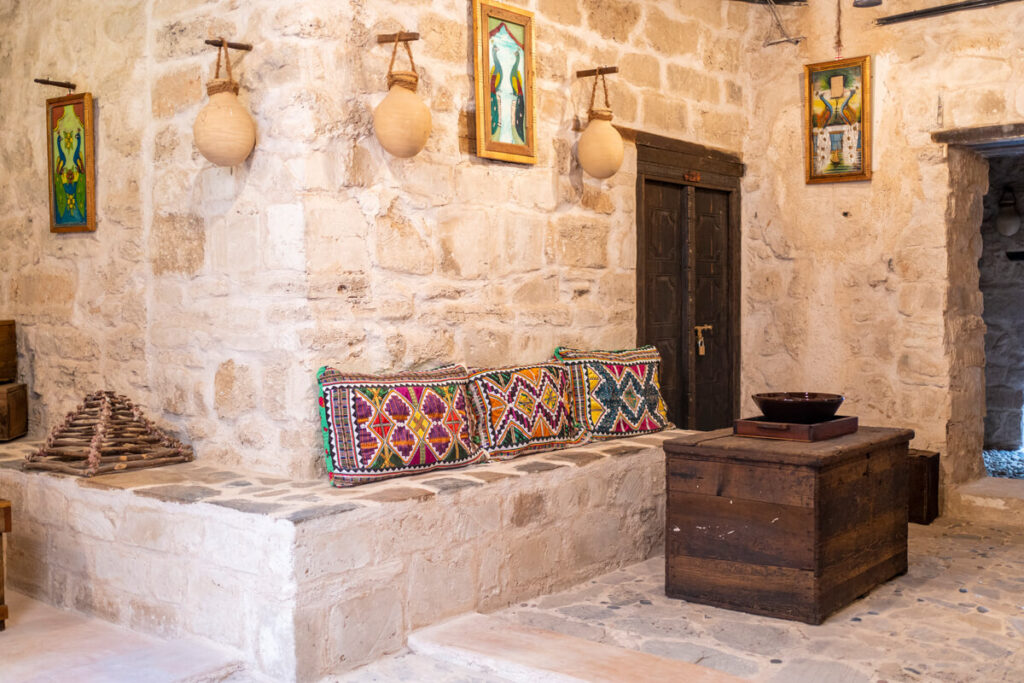
Day 11: Oman Ocean Drive to Duqm
- Daily distance: 635 kilometers
- Accommodation: Season Inn Hotel Duqm*
- Highlights: Fushi Beach, Oman Ocean Drive, Canyon Viewpoint
We now slowly had to make our way north again. But everything step by step. From Taqah, we continued along the coast all the way to Duqm. Shortly after Sadah, we discovered the beautiful Fushi Beach with its enormous sand dunes and a majestic mountain in the background.
After leaving the beach behind us, Road 49 continued along the sea for almost 84 kilometers (from Hasik onward, it becomes Road 42). A new, beautiful view awaited us around every bend.
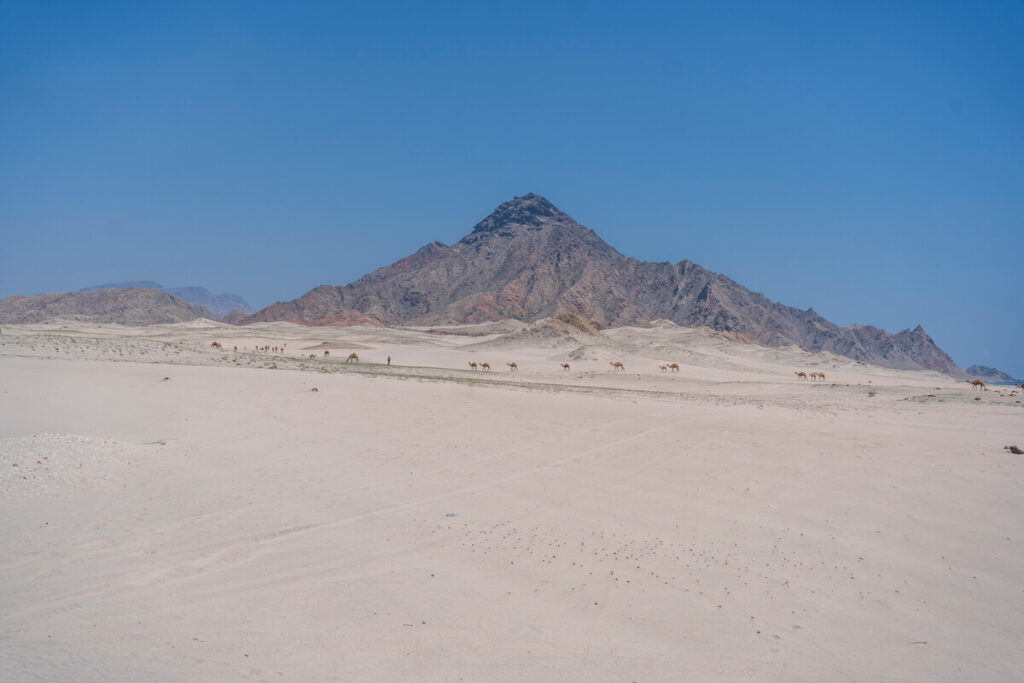
About 10 km beyond Hasik, the road climbed back up the mountains, and we reached a fantastic vantage point. From up there, we could look out over the turquoise sea, while the sea dropped hundreds of meters below us. Naturally, we immediately grabbed our binoculars and were able to spot a group of dolphins.
Almost 40 km after the aforementioned viewpoint, we reached the Canyon Viewpoint. The view is truly spectacular and once again demonstrated to us how diverse Oman is.
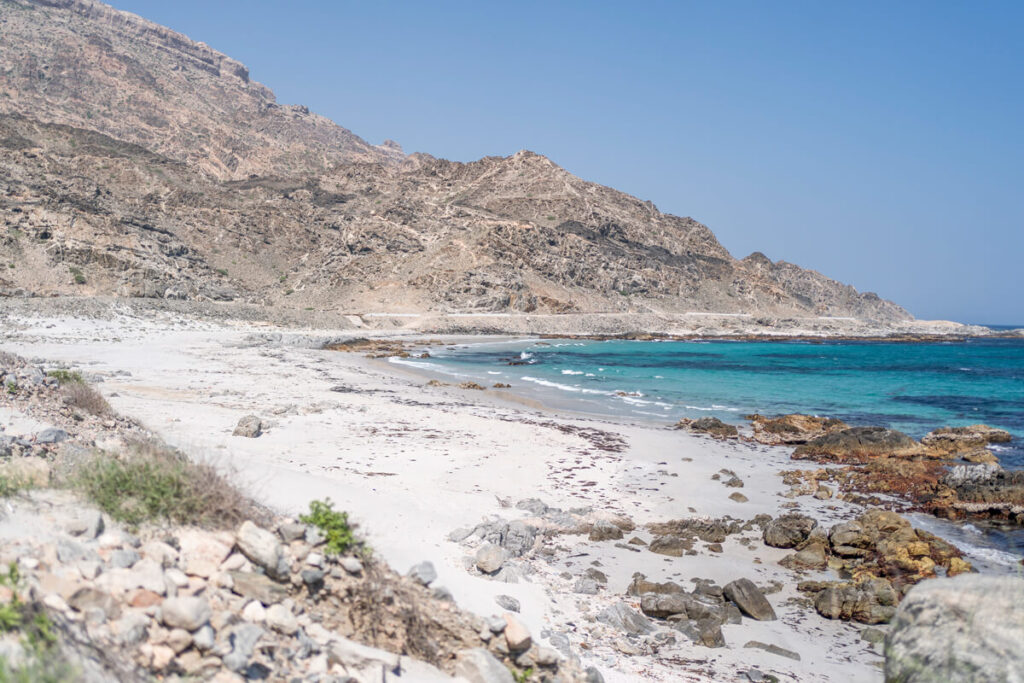
Unfortunately, we started much too late that day, which meant we had to drive the last two hours in complete darkness. We don’t recommend that. Therefore, you shouldn’t leave Taqah any later than 8 a.m. We arrived in Duqm around 8 p.m. and checked into our room. The city has restaurants, supermarkets, gas stations, and numerous accommodations. For dinner, we recommend the Salkara Family Restaurant and for a good coffee in the morning, the Pressed Café.
Day 12: Visit Lizq Oasis Farm
- Daily distance: 410 kilometers
- Accommodation: Lizq Oasis*
- Highlights: Simply enjoy the time on the farm!
410 kilometers lay ahead of us, marking the last long drive of this round trip. We took a train to Lizq, a small town near Ibra and Sinaw. On this day, we simply wanted to relax and unwind.
For this purpose, we booked a super charming cabin on a farm. Lizq Oasis* is a family-run farm where plenty of vegetables, fruit, and herbs are grown. We ended the day comfortably between over 200 different fruit trees and countless vegetable beds.
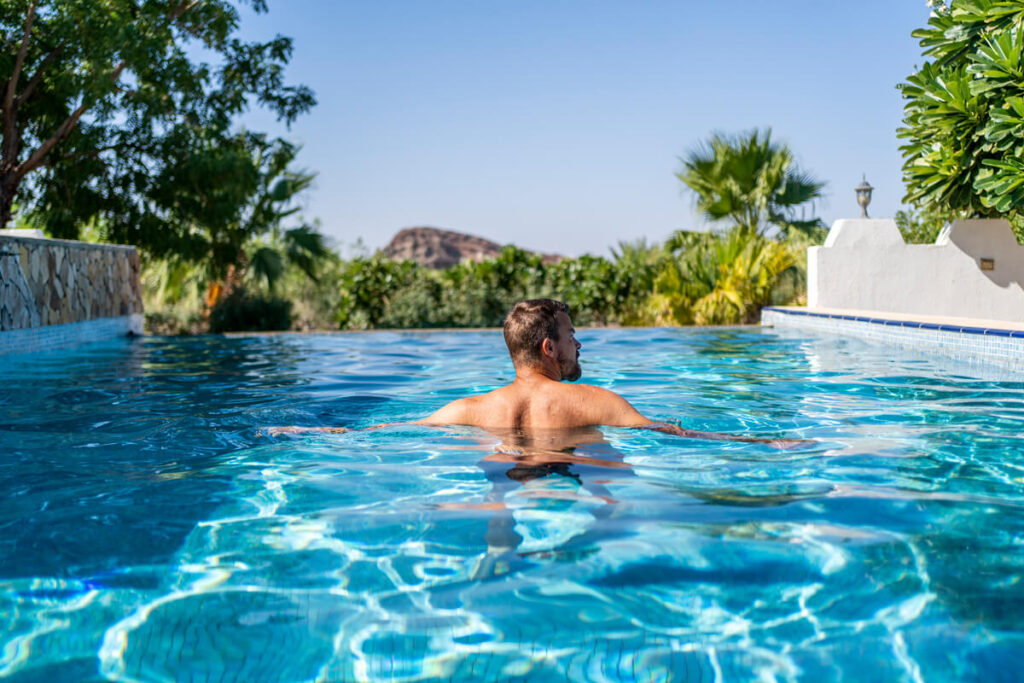
Day 13: Our Night in the Wahiba Sands Desert
- Daily Stage: 120 Kilometers
- Accommodation: Nomadic Desert Camp*
- Highlights: Desert Camp, Photographing the Milky Way, Campfire in the Desert
- Activities: Wahiba Desert and Wadi Bani Khalid Guided Group Tour*
On this day, we slept in, used the farm’s beautiful pool once again, and then headed off towards At lunchtime, we headed to our meeting point in Al Wasil (a 1.5-hour drive). There, we were to meet our guide from the Nomadic Desert Camp* and other guests. We drove in convoy to the camp in the middle of the Wahiba Sands Desert. We were particularly looking forward to this day of our tour, as deserts have a very special effect on us.
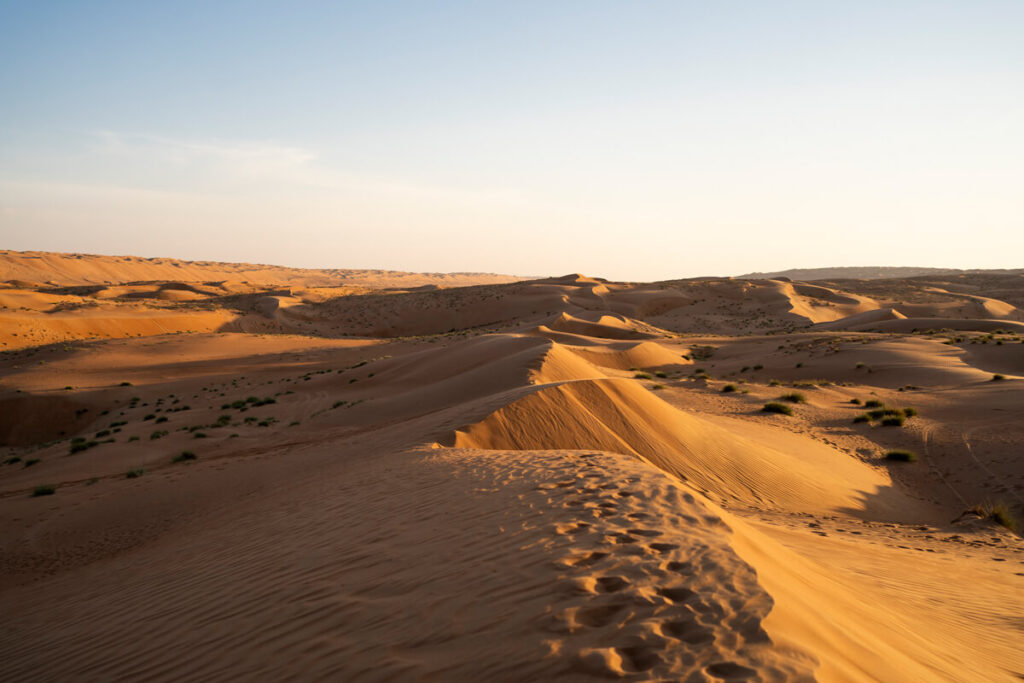
We strolled across the beautiful sand dunes, let the fine sand slide through our hands, and took countless photos of the desert. By 6 p.m. it was already dark, and right after dinner we hiked up the dunes again to photograph the gigantic Milky Way in the sky.
The silence and darkness in the desert are truly an experience in themselves. So if you’re planning a tour of Oman, you shouldn’t miss a detour to the desert. You can read more about it here: the Wahiba Sands Desert in Oman.
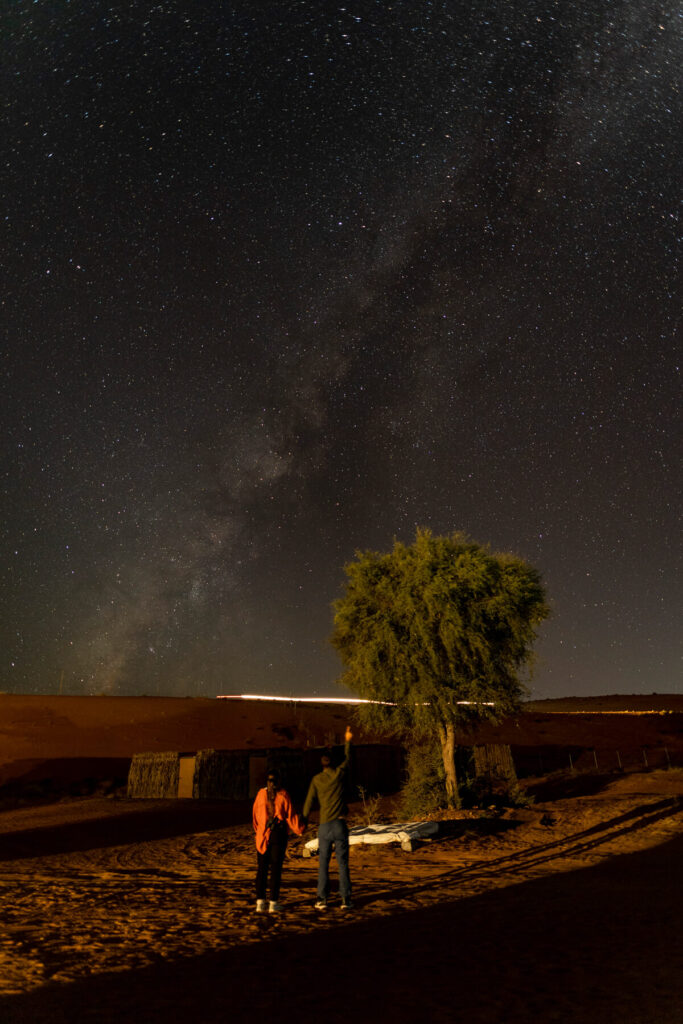
Day 14: Wadi Bani Khalid & Sur
- Daily distance: 201 kilometers
- Accommodation: Sur Grand Hotel (better book something else!)
- Highlights: Swimming in Wadi Bani Khalid, beach walk in Sur
- Activities: From Muscat: Highlights of Oman – 4-Day Tour*
After this gigantic highlight in the desert, we continued our Oman road trip. We drove for just under 1.5 hours to the popular Wadi Bani Khalid. This wadi is famous for its clear water pools and green oases. Surrounded by barren mountains and lush vegetation, Wadi Bani Khalid invites you to swim and relax amidst surreal nature. Be sure to bring water shoes and take a dip in the refreshing water.

From the wadi, we continued for almost 2 hours to the port town of Sur. Here, we ended the day by the sea. We can recommend the Phenuq Café, which offers good coffee and delicious cakes. Our accommodation that day was merely a “means to an end” and therefore didn’t really have much charm (Grand Hotel Sur). However, it was sufficient for an overnight stay. On this day we jumped into bed early so that we could start our new adventure refreshed the next morning.
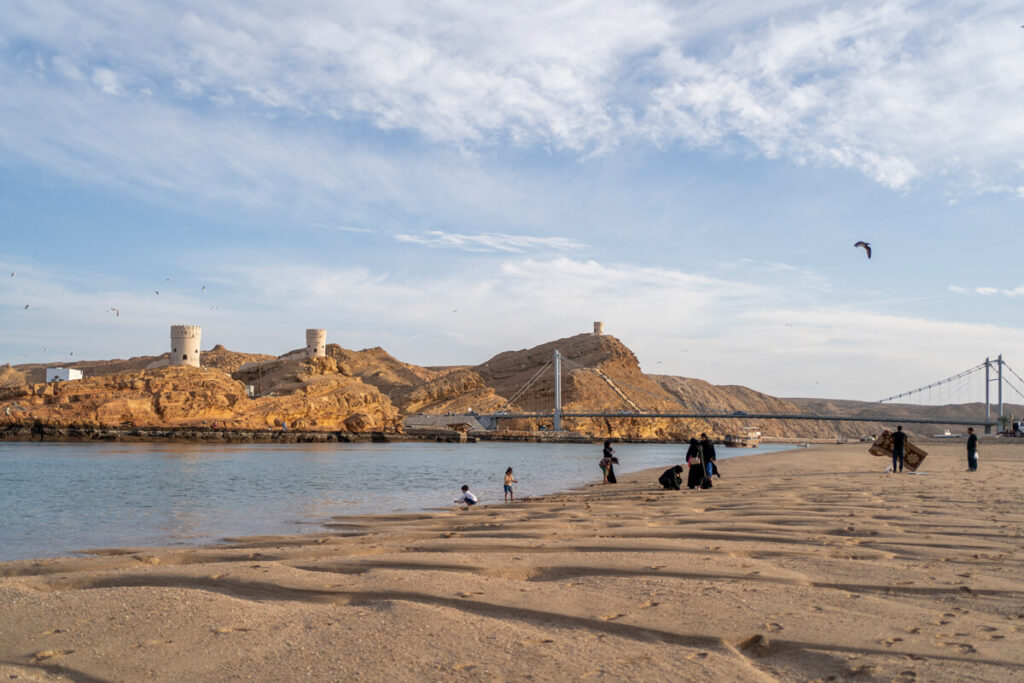
Day 15: Wadi Shab & Accommodation by the Sea
- Daily Distance: 47 kilometers
- Accommodation: Airbnb with Sea View
- Highlights: Excursion to Wadi Shab, cave with waterfall, sea view from the room
- Activities: Wadi Shab and Bimah Sinkhole Tour*
Our trip was slowly coming to an end. But two truly amazing highlights were still waiting for us. From Sur, we drove early in the morning to Wadi Shab (approx. 40 kilometers), a very popular wadi on the Omani coast. Wadi Shab is famous for its impressive gorge, turquoise pools, imposing rock formations, and lush vegetation.
The name “Shab” means “ravine” in Arabic, which aptly describes the topography of this magnificent landscape. You can read more about our trip here: Wadi Shab in Oman.
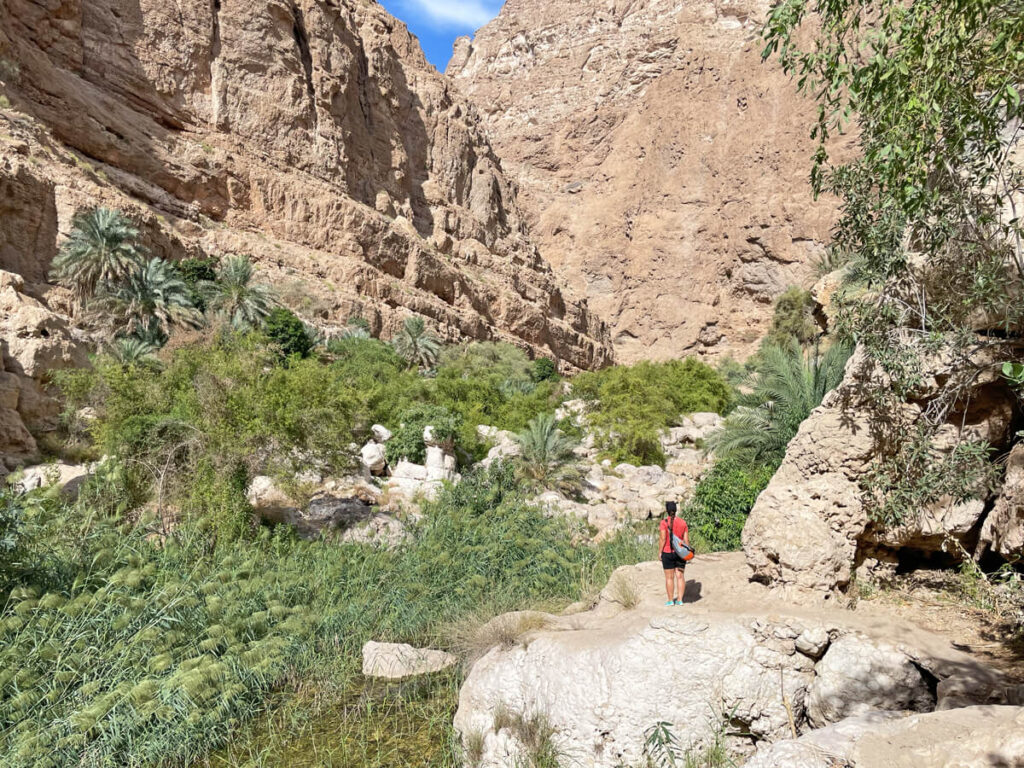
After an adventurous morning in Wadi Shab, we drove just 5 minutes to our accommodation. We stayed one night in a local’s Airbnb. In his house, we had a great room with a view of the azure sea. We could watch turtles in the sea right from our terrace.
I don’t think we’ve ever stayed in accommodation with such a gigantic view. We relaxed by the small pool, enjoyed the sun, and in the evening, indulged ourselves with culinary delights at the local restaurant Mubarak Juma Mubarak in Tiwi.

Day 16: Wadi Al Arbeieen
- Daily stage: 50 kilometers
- Accommodation: Wadi Al Arbeieen Resort*
- Highlights: Exploring the wadi, the evening at the resort
- Activities: Day trip to Wadi Tiwi, Fins Beach, Bimmah Sinkhole*
For the last full day of our trip, we once again had a truly A must-see spot on our list. The Wadi Al Arbeieen is surrounded by an impressive mountain landscape characterized by steep cliffs, green palm groves, and rocky formations.
The wadi is also known for its natural pools, which collect water from the surrounding mountains. From our beautiful accommodation (Wadi Al Arbeieen Resort*), it was only a stone’s throw to a small waterfall and some picturesque pools.
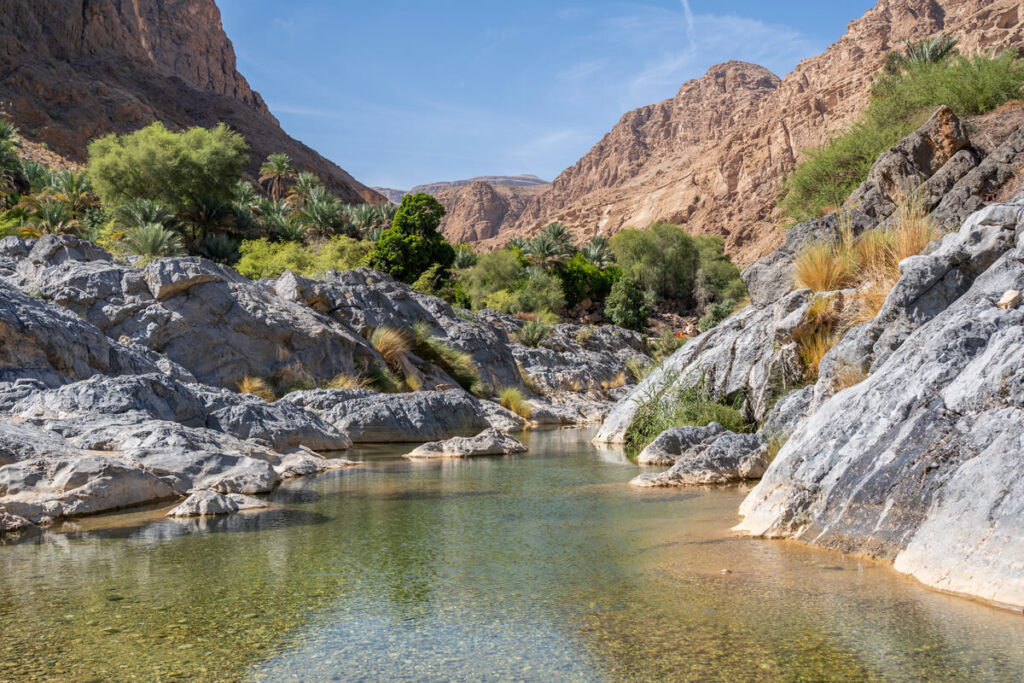
We enjoyed the last few hours under the Omani sun, swam through crystal-clear pools amidst the impressive mountain landscape, and feasted on the lavish buffet at our accommodation in the evening. Over a Coke by the campfire, we reflected on the trip and still couldn’t believe everything we had experienced in those 17 days. Incredible! One last look at the beautiful starry sky and we disappeared into our bed happy and content.
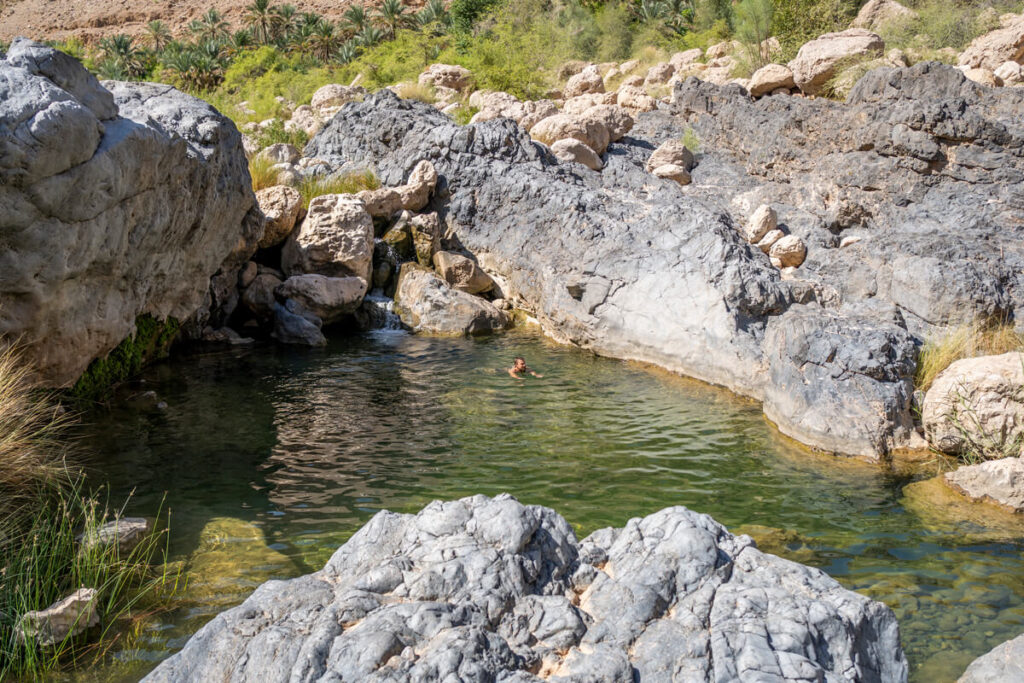
Day 17: Return to Muscat & Journey Home
- Daily Stage: 139 kilometers
- Accommodation: Primeclass Lounge & Airplane
- Highlights: Wadi Al Arbeieen, Bella Vista Café, Primeclass Lounge at the Airport
- Activities: Day tour along the coast from Muscat*
We took it easy on the last day of our Oman tour. Since the plane didn’t take off until late in the evening, we had the whole day. In the morning, we took one last dip in the wadi’s natural pools before embarking on the last drive of the trip. Around 2 p.m., we were back in the capital, Muscat, where we went back to the Bella Vista Café to enjoy another delicious coffee and cake.
Afterwards, we picked up some souvenirs at the Mutrah Souk, bought a few treats at the supermarket, and had the car washed. We returned to the airport in the early evening, returned the rental car, and relaxed in the truly beautiful Primeclass Lounge at the airport. There, we were able to enjoy another leisurely dinner. Around 10:30 p.m., we began our long journey home from Muscat via Abu Dhabi and Munich to Rostock.
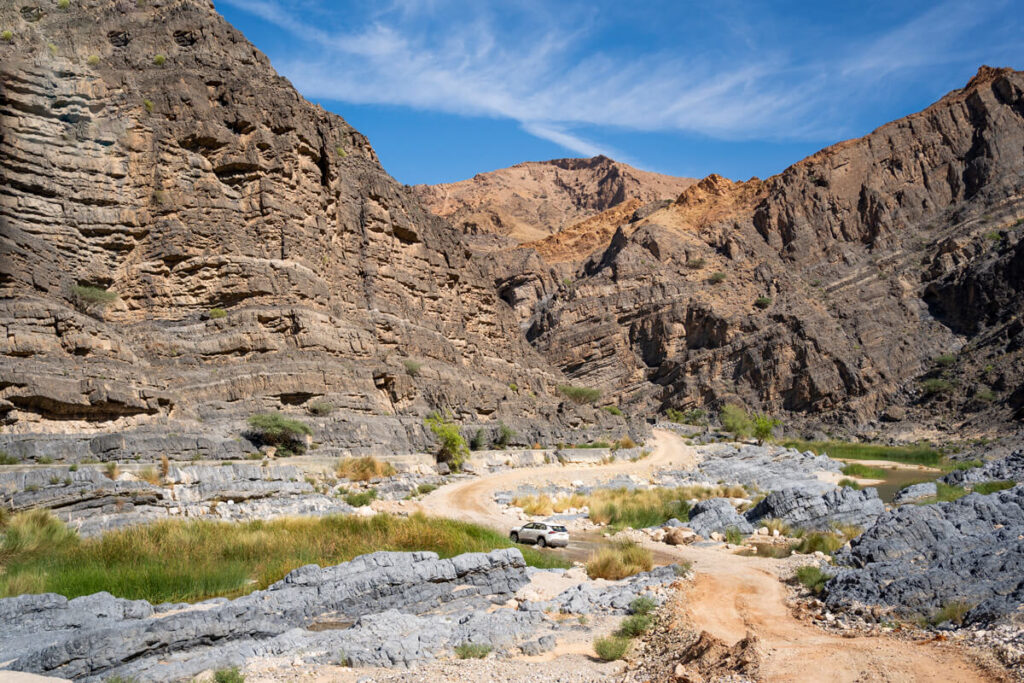
Arrival by plane
The main airport in Oman is Muscat International Airport (airport code: MCT), located in the capital city of Muscat. The airport in the south of the country is in Salalah and is also often used for travel from the north to the south.
We flew from Munich to Muscat with Etihad Airways via Abu Dhabi. Alternatively, you can also fly directly with Oman Air or Lufthansa from Munich or Frankfurt. The low-cost airline SalamAir also flies directly to Muscat from Munich.
If you don’t mind changing planes, you can also fly with Turkish Airlines (via Istanbul), SWISS (via Zurich), Emirates (via Dubai), or Qatar Airways (via Qatar). These airlines usually have a stopover in their home country. We really enjoy flying with Etihad Airways, but would choose a direct flight next time to save time.
Entry & Visa
To enter Oman, you need a valid passport that is valid for at least six months beyond your intended departure date. If you are planning a 14-day trip, according to current information from the Omani Ministry of Foreign Affairs, you do not need a visa.
We were in the country for 17 days and therefore also had to apply for a visa in advance. We were able to apply for and pay for this visa easily online via the Royal Oman Police website (approx. €50).
When is the best time to travel to Oman?
The best time to travel to Oman depends on your individual preferences and planned activities. Generally, you can travel to Oman all year round, as the climate varies from region to region. However, the most popular time to travel to Oman is winter (November – February). Temperatures are pleasantly warm between 20 and 30 degrees Celsius, and the nights are pleasantly cool. This is a great time for outdoor activities and sightseeing.
The summer months (May – September) can be very hot, especially in the coastal areas and the desert. Daytime temperatures often rise above 40 degrees Celsius. If you can tolerate the heat and want to enjoy water sports on the coast, this could still be an option. The mountainous regions are more pleasant during this time. However, we recommend the months between October and March. You can find a detailed article on this topic here:
Is Oman a safe travel destination?
Oman is one of the safest countries in the world. In a 2017 global ranking by the World Economic Forum (WEF), the Sultanate of Oman ranked 4th, just behind Finland, the United Arab Emirates, and Iceland. The Omani government attaches great importance to the safety of tourists and locals and has taken measures to ensure security in the country.
The country has a very good reputation for political stability and low crime rates. In general, crime is almost a foreign word in the country and is punished harshly. We have rarely felt as comfortable and safe as we did in Oman. We didn’t have a single negative experience. The people are very friendly, helpful, and cosmopolitan.
Not once did anyone try to take money from our pockets or steal from us. We were able to leave our belongings in the car and didn’t have to worry about a break-in. Therefore, we can answer the question of whether Oman is a safe travel destination with a clear “YES.”
What accommodations do you recommend?
In Oman, you will find numerous hotels, guesthouses, apartments, and very special accommodations, such as tents. We stayed in 12 different accommodations during our Oman road trip.
Sometimes it was a modern hotel, sometimes an apartment, and sometimes a room in a traditional mud house. If you’d like to know exactly which accommodations we stayed in, take a look at our separate post:
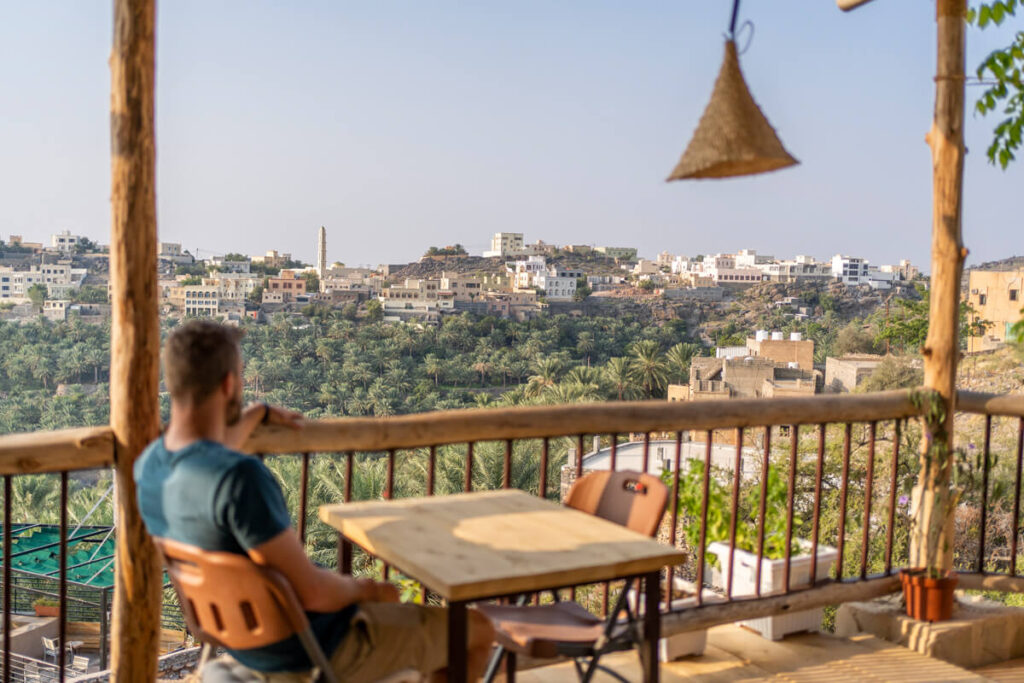
Where is the best place to book a rental car for Oman?
For our road trip through Oman, we rented a four-wheel drive vehicle (4×4). While we usually find what we’re looking for at www.billiger-mietwagen.de*, this time we found the best deal at www.check24.de*. We paid a total of €859.22 for 14 days for our Toyota RAV4. Thanks to an activated Check24 voucher, we even received an additional €25 credited to our bank account after the trip.
A four-wheel drive vehicle was necessary for our trip, as we wanted to drive into the desert ourselves, among other things, and also into a few wadis. However, you don’t necessarily need a 4×4 for the standard highlights. You can even drive into the mountains (Jebel Shams) with a regular car. You’d only have to organize the trip into the desert with a pre-booked transfer.
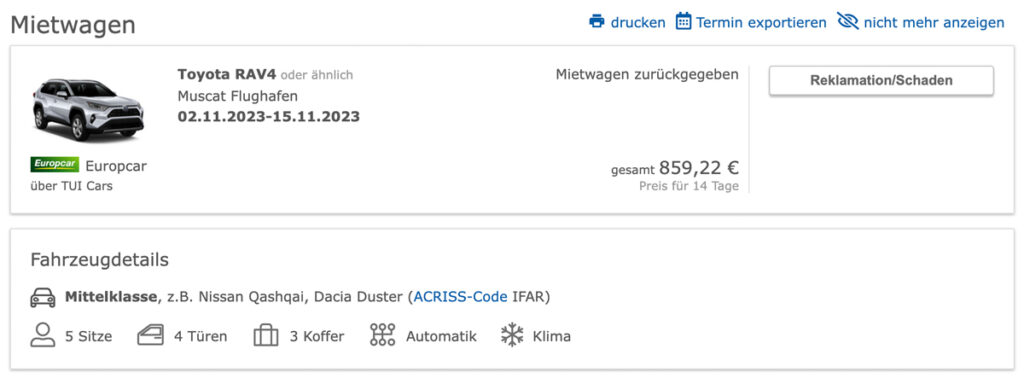
Plus point: The driving experience, ground clearance, and power are simply much better with a four-wheel drive vehicle, especially on unpaved roads. We would have been reluctant to do some of the routes with a regular car, such as those into the mountains (Jebel Shams) or to one or two of the more remote wadis. Therefore, the additional cost of approximately €300 (compared to a car) was definitely worth it for us.
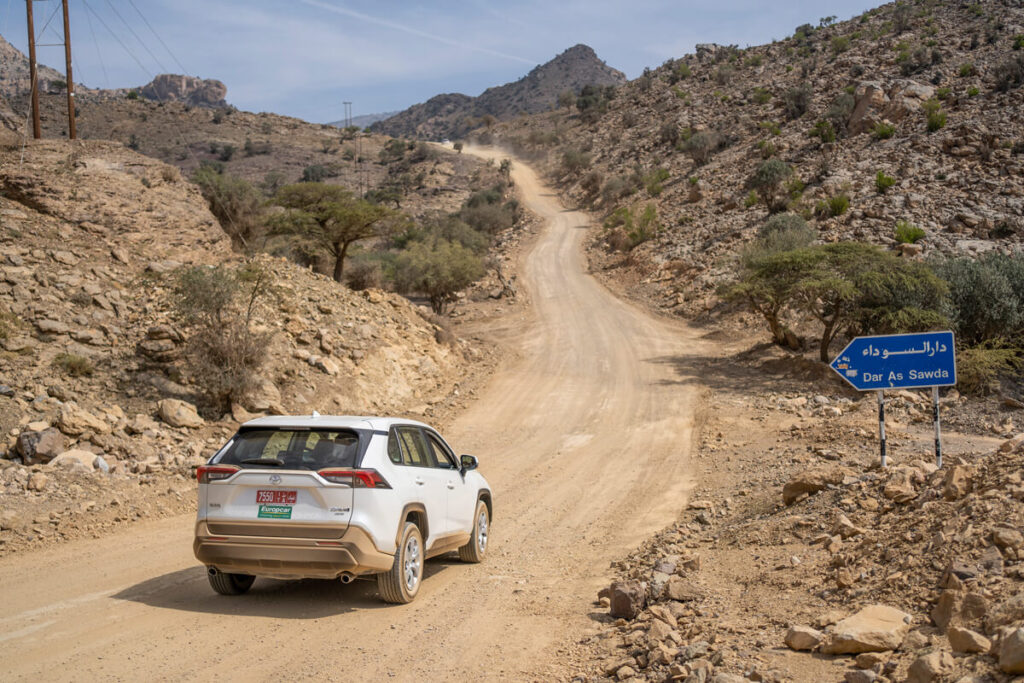
Oman Road Trip – How Safe is Driving?
In general, driving in Oman can be considered safe. The country has well-developed roads, especially in urban areas and along major highways. The infrastructure has improved considerably in recent years, and most roads are in good condition. However, when driving through more rural and desert areas, you should expect unpaved roads. The road quality in some wadis can also vary considerably.
Traffic rules in Oman are similar to those in many Western countries. Traffic drives on the right. Observe the posted speed limits in Oman, which can vary depending on the type of road. While you can drive 120 km/h on highways, the speed limit is usually 80 km/h to 100 km/h on country roads, and 40 km/h to 60 km/h within cities. Speed cameras are common in Oman, especially in the north. So stick to the speed limits.
How much does a round trip like this cost?
How much a trip to Oman ultimately costs depends on your needs. While some prefer to stay in 5-star resorts, others prefer a much simpler experience. The type of trip, the length of your trip, and the month of your trip all play an important role.
We traveled through Oman for 17 days in November and spent approximately €2,250.00 per person. This price includes flights, rental cars, gas, hotels, activities, souvenirs, food, and drinks. You can find a detailed article on this topic here:
Packing List – What Should I Not Forget?
If you’re planning a trip to Oman, there are a few things you absolutely shouldn’t forget in your luggage. We will publish a detailed packing list with all the information about our clothing, technology, and other gadgets. We have listed the most important things for you below:
Packing list for the Oman road trip
- Light and breathable clothing (muted colors are best)
- Headgear (cap, hat, scarf) and sunglasses
- Sunscreen with a high SPF and Mosquito spray
- Water shoes* and dry bag* (especially for the wadis)
- Power adapter* (type G plug) and USB hub*
- Power bank* for charging on the go
- Daypack for excursions
- Travel credit cards for withdrawing money and paying in Oman
- Flashlight/headlamp for nighttime activities
Which travel guide do you recommend?
We love travel guides and have been big fans of the DuMont series for many years. We have countless travel guides on our shelves, and there are sure to be many more to come. For our tour, we purchased the DuMont travel guide to Oman* and the Oman travel guide from Reise Know-How Verlag* in advance. We were able to use many tips in both books to plan our own trip. We also enjoy researching a country in depth before traveling.